Exploring Pakistan’s Cultural Heritage: A Journey Through Time and Diversity
Pakistan is a land of rich culture and diversity, with a long and fascinating history spanning thousands of years. Its cultural heritage is a treasure trove of art, music, literature, architecture, and folk traditions that reflects the country’s unique blend of ethnicities, religions, and languages. In this article, we take a journey through time and diversity to explore Pakistan’s cultural heritage, its roots, and its significance in today’s world.
Prehistoric Heritage
Pakistan’s cultural heritage dates back to prehistoric times, with evidence of human settlements found in the Indus Valley Civilization, one of the world’s oldest civilizations. The civilization flourished from 3300 BCE to 1300 BCE and was known for its advanced urban planning, art, and writing systems. The city of Mohenjo-Daro, a World Heritage Site, is the most prominent example of the civilization’s architectural marvels, with its complex drainage systems, public baths, and granaries.
Mughal Era
Pakistan’s cultural heritage was further enriched during the Mughal era (1526-1857) when the country was ruled by a Muslim dynasty of Persian and Turkic origins. The Mughals enriched the country’s art and architecture, with awe-inspiring monuments such as the Lahore Fort, Badshahi Mosque, and Shalimar Gardens. The Taj Mahal, located across the border in India, is another world-renowned masterpiece of Mughal architecture, built by Emperor Shah Jahan in memory of his wife Mumtaz Mahal.
Folk Traditions
Pakistan’s folk traditions are a rich repository of music, dance, and literature that reflects the country’s diverse heritage. Folk songs, such as the Punjabi Tappa, Sindhi Kafi, and Balochi Leva, express feelings of love, longing, and spirituality. Folk dances, such as the Bhangra, Dhammal, and Attan, are performed on weddings and other festive occasions and showcase the performers’ skill and grace. Folk literature, such as the works of Sufi poets Bulleh Shah and Shah Abdul Latif Bhittai, encourages tolerance, compassion, and empathy, and transcends linguistic and religious barriers.
Religious Diversity
Pakistan is home to diverse religious traditions, the most prominent being Islam, practiced by over 96% of the population. However, the country also has significant Hindu, Sikh, and Christian minorities, and the religious diversity has enriched the country’s cultural fabric. The Katas Raj Temples, located in the Salt Range mountains, are a testament to the country’s Hindu heritage, while the Sikh holy site of Nankana Sahib and the Christian Cathedral of St. Patrick’s in Karachi showcase the country’s religious diversity.
Conclusion
Pakistan’s cultural heritage is a testament to its rich history, diversity, and complexity. From the ancient ruins of Mohenjo-Daro to the Mughal-era monuments and from the folk traditions to the religious diversity, the country’s cultural heritage offers a unique opportunity to experience the rich textile heritage and learn about its significance in today’s world. As Pakistan continues to evolve and grow, its cultural heritage remains a source of inspiration and pride for its people and the rest of the world.
(Note: Do you have knowledge or insights to share? Unlock new opportunities and expand your reach by joining our authors team. Click Registration to join us and share your expertise with our readers.)
Speech tips:
Please note that any statements involving politics will not be approved.
